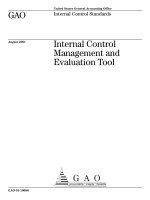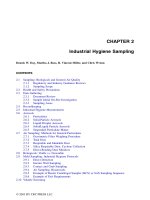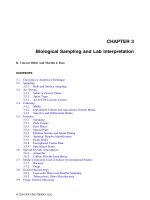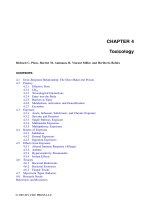INTERNAL CONTROL AND CASH handout
Bạn đang xem bản rút gọn của tài liệu. Xem và tải ngay bản đầy đủ của tài liệu tại đây (544.14 KB, 41 trang )
Chapter
Chapter 8
8
Internal Control
and Cash
Financial Accounting, Sixth Edition
Chapter
8-1
Study
Study Objectives
Objectives
1.
Define internal control.
2.
Identify the principles of internal control.
3.
Explain the applications of internal control principles
to cash receipts.
4.
Explain the applications of internal control principles
to cash disbursements.
5.
Describe the operation of a petty cash fund.
6.
Indicate the control features of a bank account.
7.
Prepare a bank reconciliation.
8.
Explain the reporting of cash.
Chapter
8-2
Internal
Internal Control
Control and
and Cash
Cash
Internal
Control
The SarbanesOxley Act
Principles
Limitations
Chapter
8-3
Cash
Controls
Control over
cash receipts
Control over
cash
disbursements
Use of a Bank
Making
deposits
Writing checks
Bank
statements
Reconciling the
bank account
Reporting
Cash
Cash
equivalents
Restricted
cash
Compensating
balances
Internal
Internal Control
Control
Methods and measures adopted to:
1. Safeguard assets.
2. Enhance accuracy and reliability of accounting
records. Reduce risk of:
a. Errors (unintentional)
b. Irregularities (intentional)
Under the Sarbanes-Oxley Act, all publicly traded U.S. corporations
are required to maintain an adequate system of internal control.
Chapter
8-4
SO 1 Define internal control.
Internal
Internal Control
Control
The Sarbanes-Oxley Act
Companies must
develop principles of control over financial
reporting.
continually verify that controls are working.
Independent auditors must attest to the level of
internal control.
SOX created the Public Company Accounting
Oversight Board (PCAOB).
Chapter
8-5
SO 1 Define internal control.
Internal
Internal Control
Control
Principles of Internal Control
Illustration 8-1
Measures vary with
size and nature of
the business.
management’s control
philosophy.
Chapter
8-6
SO 2 Identify the principles of internal control.
Internal
Internal Control
Control
Principles of Internal Control
ESTABLISHMENT OF RESPONSIBILITY
Control is most effective when only one person is
responsible for a given task.
SEGREGATION OF DUTIES
Related duties should be assigned to different individuals.
DOCUMENTATION PROCEDURES
Companies should use prenumbered documents and all
documents should be accounted for.
Chapter
8-7
SO 2 Identify the principles of internal control.
Internal
Internal Control
Control
Principles of Internal Control
Illustration 8-3
PHYSICAL, MECHANICAL, AND ELECTRONIC CONTROLS
Physical
Mechanical
and
Electronic
Chapter
8-8
SO 2 Identify the principles of internal control.
Internal
Internal Control
Control
Principles of Internal Control
INDEPENDENT INTERNAL VERIFICATION
1. Records periodically verified by an employee who is
independent.
2. Discrepancies reported to management.
OTHER CONTROLS
1. Bond employees.
2. Rotate employees’ duties and require vacations.
3. Conduct background checks.
Chapter
8-9
SO 2 Identify the principles of internal control.
Internal
Internal Control
Control
Limitations of Internal Control
Costs should not exceed benefit.
Human element.
Size of the business.
Chapter
8-10
SO 2 Identify the principles of internal control.
Cash
Cash Controls
Controls
Illustration 8-5
Internal Control over Cash Receipts
Establishment of
Responsibility
Documentation
Procedures
Independent Internal
Verification
Only designated
personnel are
authorized to handle
cash receipts
(cashiers)
Use remittance
advice (mail
receipts), cash
register tapes, and
deposit slips
Supervisors count cash
receipts daily;
treasurer compares
total receipts to bank
deposits daily
Segregation of Duties
Physical,
Mechanical, and
Electronic Controls
Other Controls
Different individuals
receive cash, record
cash receipts, and hold
the cash
Chapter
8-11
Store cash in safes
and bank vaults; limit
access to storage
areas; use cash
registers
Bond personnel who
handle cash; require
employees to take
vacations; deposit all
cash in bank daily
SO 3 Explain the applications of internal control principles to cash receipts.
Cash
Cash Controls
Controls
Cash consists of coins, currency, checks, money
orders, and money on hand or on deposit in a bank.
Cash receipts come from:
cash sales
collections on account from customers
receipt of interest, rent, and dividends
investments by owners
bank loans
proceeds from the sale of noncurrent assets
Chapter
8-12
SO 3 Explain the applications of internal control principles to cash receipts.
Over-the-Counter
Over-the-Counter Receipts
Receipts
Cashier’s Department
Sales Department
Illustration 8-7
Prepare daily summary
Prepare deposit slip
Cashier ring up sales
Supervisor
1. reads register totals
2. makes cash counts
3. prepares cash count
sheets
Chapter
8-13
Bank
Treasurer Accounting
(deposit) (verification)
(record)
SO 3 Explain the applications of internal control principles to cash receipts.
Mail Receipts
Receipts
Control Procedures:
Mail receipts should be opened by two people, a
list prepared, and each check endorsed.
Copy of the list, along with the checks and
remittance advices, sent to cashier’s department.
Cashier adds the checks to the over-the-counter
receipts and prepares a daily cash summary and
makes the daily bank deposit.
Copy of list sent to treasurer’s office for
comparison with total shown on daily cash
summary.
Chapter
8-14
SO 3 Explain the applications of internal control principles to cash receipts.
Cash
Cash Controls
Controls
Illustration 8-8
Internal Control over Cash Disbursements
Establishment of
Responsibility
Documentation
Procedures
Independent Internal
Verification
Only designated
personnel are
authorized to sign
checks (treasurer)
Use prenumbered
checks and account
for them in sequence;
each check must
have an approved
invoice
Compare checks to
invoices; reconcile bank
statement monthly
Other Controls
Store blank checks in
safes, with limited
access; print check
amounts by machine in
indelible ink
Segregation of Duties
Different individuals
approve and make
payments; check
signers do not record
disbursements
Chapter
8-15
Stamp invoices
PAID
Physical, Mechanical,
and Electronic
Controls
SO 4 Explain the applications of internal control
principles to cash disbursements.
Cash
Cash Controls
Controls
Internal Control over Cash Disbursements
Generally, internal control over cash
disbursements is more effective when
companies pay by check, rather than by cash.
Applications:
Voucher system
Electronic funds transfers (EFT) system
Petty cash fund
Chapter
8-16
SO 4 Explain the applications of internal control
principles to cash disbursements.
Cash
Cash Controls
Controls
Internal Control over Cash Disbursements
Voucher System
Network of approvals, by authorized
individuals, to ensure all disbursements by
check are proper.
A voucher is an authorization form prepared
for each expenditure.
Chapter
8-17
SO 4 Explain the applications of internal control
principles to cash disbursements.
Cash
Cash Controls
Controls
Internal Control over Cash Disbursements
Electronic Funds Transfers (EFT)
Disbursement systems that uses wire,
telephone, or computers to transfer cash
balances between locations.
Chapter
8-18
SO 4 Explain the applications of internal control
principles to cash disbursements.
Cash
Cash Controls
Controls
Internal Control over Cash Disbursements
Petty Cash Fund - Used to pay small amounts.
Involves:
1. establishing the fund,
2. making payments from the fund, and
3. replenishing the fund.
Chapter
8-19
SO 5 Describe the operation of a petty cash fund.
Cash
Cash Controls
Controls
E8-8 Lincolnville Company uses an imprest petty cash system. The
fund was established on March 1 with a balance of $100. During
March the following petty cash receipts were found in the petty cash
box.
Receipt
Date
No.
For
3/5
1
Stamp inventory
7
2
Freight-out
9
3
Miscellaneous expense
11
4
Travel expense
14
5
Miscellaneous expense
Amount
$
39
21
6
24
5
The fund was replenished on March 15 when the fund contained $3 in
cash. On March 20, the amount in the fund was increased to $150.
Instructions: Journalize the entries in March that pertain to the
operation of the petty cash fund.
Chapter
8-20
SO 5 Describe the operation of a petty cash fund.









